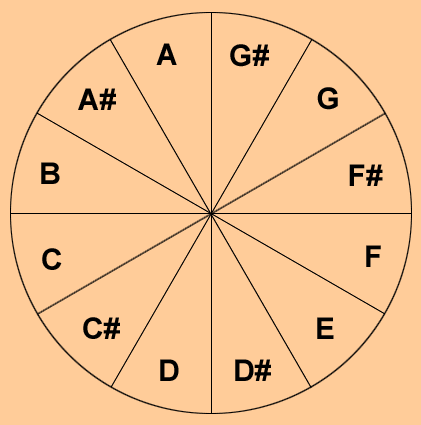| Playing with other Didjes in Harmony |
|
This Circle of Musical Keys was shown to me by Kevin, a very good friend and musician. When I asked Kevin which keys are harmonious and which ones are not, he drew a circle, divided it into twelve equal parts and starting with C he proceeded to enter all musical keys anti-clockwise. The result you can see here on the right. Kevin told me that opposing keys and keys right next to each other are most discordant (sound the worst together) while nearly opposing keys are most harmonious together (i.e. C and F or C and G). So if you want to play two didjes together, use this rule to find what other didj you can play with a given key. So to find what other keys sound best with a given key, you find the two keys next to the opposing key in the circle. If you want to play three didjes in different keys together, you can play the starting key and both of the keys next to the opposing key (i.e. a C with both F and G) at the same time. However C, E and G will sound even better together as they build a triad. Triads can be found by going four steps from the starting key and then three more counterclockwise. So D#, G and A# sound really good together. This is the formula for creating major scale triads using this circle. Some of you musicians out there might be able to share a bit more wisdom about musical harmonies with the ignorant rest of us. Please contact me if you have any such wisdom to share. Thanks
|
|
Home | About Us | Checkout | Community | Help | Information | Shopping Didj Forum | Send a Didj Greeting Card | Guest Book |
| © Didjshop.com, 1993-. For rights reserved and granted see our Copyright notice. |

 When playing several didjes together, in my ears
some sound good played together and others sound not so good. Since I am not a trained musician and had no idea about musical harmonies, I asked
some friends.
When playing several didjes together, in my ears
some sound good played together and others sound not so good. Since I am not a trained musician and had no idea about musical harmonies, I asked
some friends.